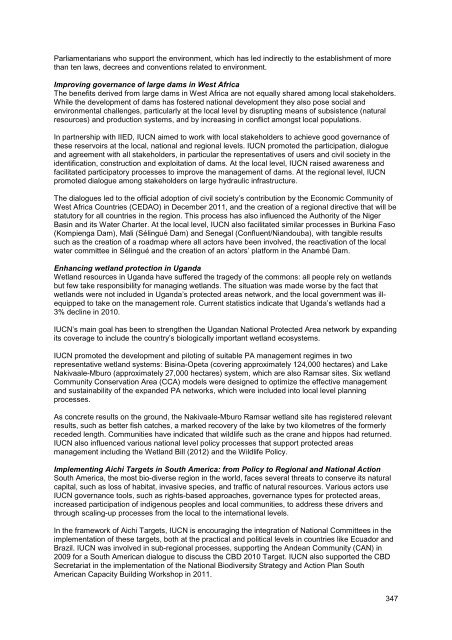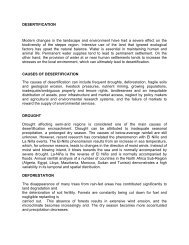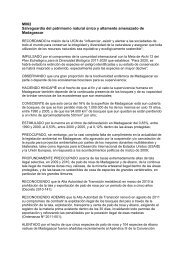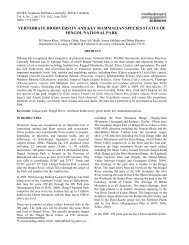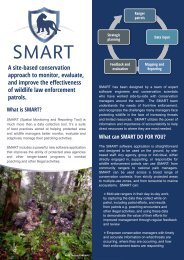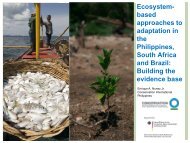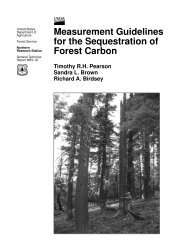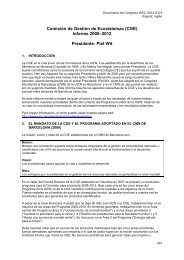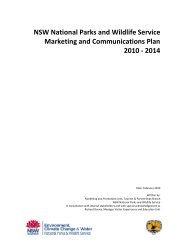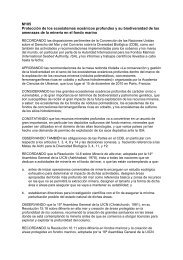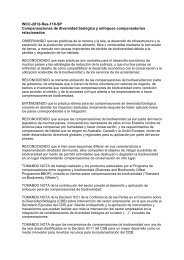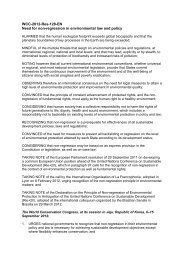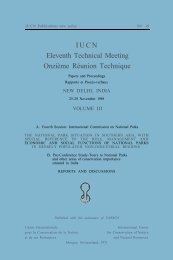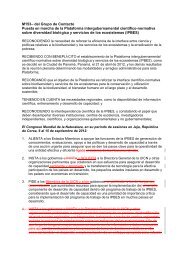progressively worsening water crisis. Much of the original broadleaf forest in the Miyun watershed haddisappeared. Reforestation activities p<strong>la</strong>nted <strong>la</strong>rge areas of conifers and other species, and institutedstrict controls on <strong>la</strong>nd and forest use, including a total ban on logging. Four years ago, the problemwas that these strictly protected and mainly young, even-aged stands of trees were in a poorcondition. This was because they had not been actively managed. Local communities had alsobecome progressively disadvantaged in economic terms over the <strong>la</strong>st <strong>de</strong>ca<strong>de</strong>s, as a result of thelogging ban and strict regu<strong>la</strong>tion of their access to forests.It was against this backdrop that <strong>IUCN</strong>’s Livelihoods and Landscapes (LLS) project was initiated in theMiyun watershed in 2007. The project’s aim is “the establishment of national and local policies andprogrammes that optimize forest’s contribution to rural poverty reduction enhances long-term an<strong>de</strong>quitable conservation of biodiversity and ensures the sustainable supply of forest-re<strong>la</strong>ted goods andservices”.The project introduced a new set of forest management tools which represented a shift from a strictlyprotective and very conservative regime, to one which was based on sustainable use and activemanagement by local communities. At the same time, consi<strong>de</strong>rable efforts were ma<strong>de</strong> to find otherways of strengthening livelihoods, promoting sustainable forest use, and adding value at the locallevel.Among the main results of this project is the creation and support of a trans-boundary and inter-sectorcooperation mechanism for managing Miyun watershed. A road map was <strong>de</strong>veloped to support futurewatershed governance initiatives and a liaison group formed to trans<strong>la</strong>te willingness to actions. Theneed to establish a sustainable financing mechanism was i<strong>de</strong>ntified, leading to the prioritization an<strong>de</strong>conomic analysis of Forest Landscape Restoration (FLR) in Miyun. A second pilot phase wasimplemented in Hebei province and scaling up efforts were un<strong>de</strong>rtaken to promote Forest LandscapeRestoration across the country.Demonstration activities led to the <strong>de</strong>velopment of forest management p<strong>la</strong>ns for two vil<strong>la</strong>ges, improvedforest management in two pilot sites covering 80 hectares and direct benefits to nearly 60 householdsin the form of increases in local incomes.Accession of Lao PDR to the Ramsar ConventionOf the four countries in the Lower Mekong Basin only Lao PDR was not a member country of theRamsar Convention on Wet<strong>la</strong>nds of International Significance. Lao wet<strong>la</strong>nds, including those ofinternational importance, were neither effectively protected nor managed, leading to the loss of somewet<strong>la</strong>nds and wet<strong>la</strong>nd functions. To address this situation <strong>IUCN</strong> supported the accession of Lao PDRin 2010 to the Ramsar Convention on Wet<strong>la</strong>nds of International Significance, and a subsequentincreased coverage of wet<strong>la</strong>nds un<strong>de</strong>r the convention<strong>IUCN</strong> i<strong>de</strong>ntified key materials for advocacy and awareness raising, and trans<strong>la</strong>ted relevant documentsand materials from the Ramsar Secretariat into the Lao <strong>la</strong>nguage. Both <strong>de</strong>cision makers and technicalofficials from the Department of Treaties of Ministry of Foreign Affairs, <strong>IUCN</strong> State member, Water,Resource and Environmental Authority, and Ministry of Agriculture and Forests worked with <strong>IUCN</strong> tofurther pursue the ratification process and influence policy, especially working through the NationalEnvironment Committee and the National Assembly.The processes took eight years leading Lao PDR to join the Ramsar Convention, as its 160thmember, on 28 September 2010, the establishment of Laos’ first two Ramsar sites (Beung Kiat Nongin Champassak province on 02 February, and Xe Champhone in Savannakhet province on 06February 2011) and the creation of a National Committee for Wet<strong>la</strong>nd Management.Leveraging policy influence in Guinee-Bissau<strong>IUCN</strong>’s work in Guinea-Bissau was originally set up to implement a coastal p<strong>la</strong>nning project, but hasemerged as a good example of working with Members and the government to create positive changesfor the environment. Through <strong>IUCN</strong>’s original work on coastal p<strong>la</strong>nning, the Institute of Biodiversity andProtected Areas and the Office of Coastal P<strong>la</strong>nning were created as two new public institutions.<strong>IUCN</strong> has worked with its nine Members in the country alongsi<strong>de</strong> the government through a dialogueto <strong>de</strong>fine priorities for investment in projects on the ground. <strong>IUCN</strong> also helped form a network of346
Parliamentarians who support the environment, which has led indirectly to the establishment of morethan ten <strong>la</strong>ws, <strong>de</strong>crees and conventions re<strong>la</strong>ted to environment.Improving governance of <strong>la</strong>rge dams in West AfricaThe benefits <strong>de</strong>rived from <strong>la</strong>rge dams in West Africa are not equally shared among local stakehol<strong>de</strong>rs.While the <strong>de</strong>velopment of dams has fostered national <strong>de</strong>velopment they also pose social an<strong>de</strong>nvironmental challenges, particu<strong>la</strong>rly at the local level by disrupting means of subsistence (naturalresources) and production systems, and by increasing in conflict amongst local popu<strong>la</strong>tions.In partnership with IIED, <strong>IUCN</strong> aimed to work with local stakehol<strong>de</strong>rs to achieve good governance ofthese reservoirs at the local, national and regional levels. <strong>IUCN</strong> promoted the participation, dialogueand agreement with all stakehol<strong>de</strong>rs, in particu<strong>la</strong>r the representatives of users and civil society in thei<strong>de</strong>ntification, construction and exploitation of dams. At the local level, <strong>IUCN</strong> raised awareness andfacilitated participatory processes to improve the management of dams. At the regional level, <strong>IUCN</strong>promoted dialogue among stakehol<strong>de</strong>rs on <strong>la</strong>rge hydraulic infrastructure.The dialogues led to the official adoption of civil society’s contribution by the Economic Community ofWest Africa Countries (CEDAO) in December 2011, and the creation of a regional directive that will bestatutory for all countries in the region. This process has also influenced the Authority of the NigerBasin and its Water Charter. At the local level, <strong>IUCN</strong> also facilitated simi<strong>la</strong>r processes in Burkina Faso(Kompienga Dam), Mali (Sélingué Dam) and Senegal (Confluent/Niandouba), with tangible resultssuch as the creation of a roadmap where all actors have been involved, the reactivation of the localwater committee in Sélingué and the creation of an actors’ p<strong>la</strong>tform in the Anambé Dam.Enhancing wet<strong>la</strong>nd protection in UgandaWet<strong>la</strong>nd resources in Uganda have suffered the tragedy of the commons: all people rely on wet<strong>la</strong>ndsbut few take responsibility for managing wet<strong>la</strong>nds. The situation was ma<strong>de</strong> worse by the fact thatwet<strong>la</strong>nds were not inclu<strong>de</strong>d in Uganda’s protected areas network, and the local government was illequippedto take on the management role. Current statistics indicate that Uganda’s wet<strong>la</strong>nds had a3% <strong>de</strong>cline in 2010.<strong>IUCN</strong>’s main goal has been to strengthen the Ugandan National Protected Area network by expandingits coverage to inclu<strong>de</strong> the country’s biologically important wet<strong>la</strong>nd ecosystems.<strong>IUCN</strong> promoted the <strong>de</strong>velopment and piloting of suitable PA management regimes in tworepresentative wet<strong>la</strong>nd systems: Bisina-Opeta (covering approximately 124,000 hectares) and LakeNakivaale-Mburo (approximately 27,000 hectares) system, which are also Ramsar sites. Six wet<strong>la</strong>ndCommunity Conservation Area (CCA) mo<strong>de</strong>ls were <strong>de</strong>signed to optimize the effective managementand sustainability of the expan<strong>de</strong>d PA networks, which were inclu<strong>de</strong>d into local level p<strong>la</strong>nningprocesses.As concrete results on the ground, the Nakivaale-Mburo Ramsar wet<strong>la</strong>nd site has registered relevantresults, such as better fish catches, a marked recovery of the <strong>la</strong>ke by two kilometres of the formerlyrece<strong>de</strong>d length. Communities have indicated that wildlife such as the crane and hippos had returned.<strong>IUCN</strong> also influenced various national level policy processes that support protected areasmanagement including the Wet<strong>la</strong>nd Bill (2012) and the Wildlife Policy.Implementing Aichi Targets in South America: from Policy to Regional and National ActionSouth America, the most bio-diverse region in the world, faces several threats to conserve its naturalcapital, such as loss of habitat, invasive species, and traffic of natural resources. Various actors use<strong>IUCN</strong> governance tools, such as rights-based approaches, governance types for protected areas,increased participation of indigenous peoples and local communities, to address these drivers andthrough scaling-up processes from the local to the international levels.In the framework of Aichi Targets, <strong>IUCN</strong> is encouraging the integration of National Committees in theimplementation of these targets, both at the practical and political levels in countries like Ecuador andBrazil. <strong>IUCN</strong> was involved in sub-regional processes, supporting the An<strong>de</strong>an Community (CAN) in2009 for a South American dialogue to discuss the CBD 2010 Target. <strong>IUCN</strong> also supported the CBDSecretariat in the implementation of the National Biodiversity Strategy and Action P<strong>la</strong>n SouthAmerican Capacity Building Workshop in 2011.347
- Page 1 and 2:
UICNCONGRESO MUNDIAL DE LA NATURALE
- Page 3 and 4:
UICNCongreso Mundial de la Naturale
- Page 5 and 6:
I. IntroducciónAcerca de este Info
- Page 7 and 8:
compromiso con el logro de nuestros
- Page 9 and 10:
creciente presencia en los medios s
- Page 11 and 12: al género y a los pueblos indígen
- Page 13 and 14: la superficie de otros ocho sitios.
- Page 15 and 16: periódicos del Consejo y de los ge
- Page 17 and 18: Refuerzo de los Comités Nacionales
- Page 19 and 20: Las Comisiones - Interacciones y cr
- Page 21 and 22: Comisión de Derecho AmbientalComo
- Page 23 and 24: Comisión Mundial de Áreas Protegi
- Page 25 and 26: Cambiar el pronóstico sobre el cli
- Page 27 and 28: de desastres como parte de su traba
- Page 29 and 30: 2. Generar resultados sobre el terr
- Page 31 and 32: El plan financiero 2009-2012 previ
- Page 33 and 34: la UICN para ejercer influencia sob
- Page 35 and 36: generando 524 comentarios, y los re
- Page 37 and 38: FIGURA 6: PERSONAL DE LA SECRETARÍ
- Page 39 and 40: Estructura de la Secretaría mundia
- Page 41 and 42: ha aumentado; por ejemplo, el núme
- Page 43 and 44: Reforzar la conservaciónDetener la
- Page 45 and 46: Documento del Congreso WCC-2012-7.1
- Page 47 and 48: • The Membership of IUCN grew by
- Page 49 and 50: management, REDD Readiness, among o
- Page 51 and 52: 20000180001600014000120001000080006
- Page 53 and 54: IUCN influenced the negotiations on
- Page 55 and 56: Development, Accor, Six Senses Reso
- Page 57 and 58: Total: CHF 354 mCHF 100mCHF 30mCHF
- Page 59 and 60: which IUCN receives framework incom
- Page 61: future assessments which IPBES migh
- Page 65 and 66: governments, the private sector and
- Page 67 and 68: Forest Landscape Restoration and th
- Page 69 and 70: As one part of this broad initiativ
- Page 71 and 72: irds’ habitat. Strict management
- Page 73 and 74: This information was used to prepar
- Page 75 and 76: IUCN and Rio Tinto have also begun
- Page 77 and 78: Documento del Congreso WCC-2012-/7.
- Page 79 and 80: 1. El enfoque de “Un solo Program
- Page 81 and 82: C. Nuestros Comités Nacionales y R
- Page 83 and 84: 4. CierreEsta Carta nos insta a tod
- Page 85 and 86: Results of the analysis and recomme
- Page 87 and 88: Documento del Congreso WCC-2012-7.1
- Page 89 and 90: Estamos de acuerdo con el objetivo
- Page 91 and 92: A continuación, resumimos nuestras
- Page 93 and 94: 10. Re-posicionar la función de ge
- Page 95 and 96: Documento del Congreso WCC-2012-7.1
- Page 97 and 98: ecosystems and biodiversity for nat
- Page 99 and 100: IUCN Red List index: guidance for n
- Page 101 and 102: Species and climate change: more th
- Page 103 and 104: Cambio climático y biodiversidad e
- Page 105 and 106: How is your MPA doing? A guidebook
- Page 107 and 108: Reflexiones Mediterráneas: año 20
- Page 109 and 110: l'espèce et plan d'action 2010-202
- Page 111 and 112: Guía para la aplicación y monitor
- Page 113 and 114:
Principios y práctica de la restau
- Page 115 and 116:
Blue carbon policy framework 2.0: b
- Page 117 and 118:
UICNCONGRESO MUNDIAL DE LA NATURALE
- Page 119 and 120:
la aprobación de la Estrategia de
- Page 121 and 122:
apuntar mucho más alto por parte d
- Page 123 and 124:
Documento del Congreso WCC-2012-8.2
- Page 125 and 126:
También existen GT que no han sido
- Page 127 and 128:
Dada la importancia de los impactos
- Page 129 and 130:
ooooooooco-organización de sesione
- Page 131 and 132:
En el pasado, los miembros de la CG
- Page 133 and 134:
entrevistas sobre los riesgos asoci
- Page 135 and 136:
ANEXO 1: Los líderes de la CGECOMI
- Page 137 and 138:
Documento del Congreso WCC-2012-8.2
- Page 139 and 140:
La CEC estimula un cambio de paradi
- Page 141 and 142:
diálogo se benefició del asesoram
- Page 143 and 144:
frecuencia para que hagan contribuc
- Page 145 and 146:
conferencia fue organizada por el V
- Page 147 and 148:
Colaboración con colaboradores est
- Page 149 and 150:
Generaciones, la Mesa redonda sobre
- Page 151 and 152:
Figura 2: La CEC ha atraído a un c
- Page 153 and 154:
adquirir información, más basada
- Page 155 and 156:
Documento del Congreso WCC-2012-8.2
- Page 157 and 158:
MEMBRESÍA DE LA CPAES POR REGIONES
- Page 159 and 160:
Elinor Ostrom, Premio Nobel 2009 de
- Page 161 and 162:
sólidas para la adaptación sensib
- Page 163 and 164:
11.1 Tema sobre pueblos indígenas
- Page 165 and 166:
13. Red de jóvenes de la CPAES - 1
- Page 167 and 168:
Comisión de Derecho Ambiental (CDA
- Page 169 and 170:
La Iniciativa en sus inicios se con
- Page 171 and 172:
FOTO: Ministro del Superior Tribuna
- Page 173 and 174:
La Comisión ha hecho un importante
- Page 175 and 176:
La tarea se inició con un grupo de
- Page 177 and 178:
Aunque es poco lo que tenemos para
- Page 179 and 180:
La Secretaría de la Academia fue e
- Page 181 and 182:
A los presidentes de los Grupos Esp
- Page 183 and 184:
muchas: desde ofrecer liderazgo con
- Page 185 and 186:
Los ecosistemas marinos continúan
- Page 187 and 188:
Documento del Congreso WCC-2012-9.1
- Page 189 and 190:
473
- Page 191 and 192:
UICN - Unión Internacional para la
- Page 193 and 194:
UICN - Unión Internacional para la
- Page 195 and 196:
UICN - Unión Internacional para la
- Page 197 and 198:
UICN - Unión Internacional para la
- Page 199 and 200:
UICN - Unión Internacional para la
- Page 201 and 202:
UICN - Unión Internacional para la
- Page 203 and 204:
UICN - Unión Internacional para la
- Page 205 and 206:
UICN - Unión Internacional para la
- Page 207 and 208:
UICN - Unión Internacional para la
- Page 209 and 210:
ANEXO A - 2011 FONDOS BÁSICOS DE A
- Page 211 and 212:
UICNCongreso Mundial de la Naturale
- Page 213 and 214:
Figura 1: Tendencias en los ingreso
- Page 215 and 216:
Ingresos y gastos para proyectosLos
- Page 217 and 218:
Tabla 4: Ingresos por acuerdos marc
- Page 219 and 220:
Tabla 7: Grandes proyectos implemen
- Page 221 and 222:
sector privado siguen siendo la fue
- Page 223 and 224:
Todas las inversiones generaron gan
- Page 225 and 226:
Se prevé que los costos relativos
- Page 227 and 228:
La moneda utilizada en los informes


